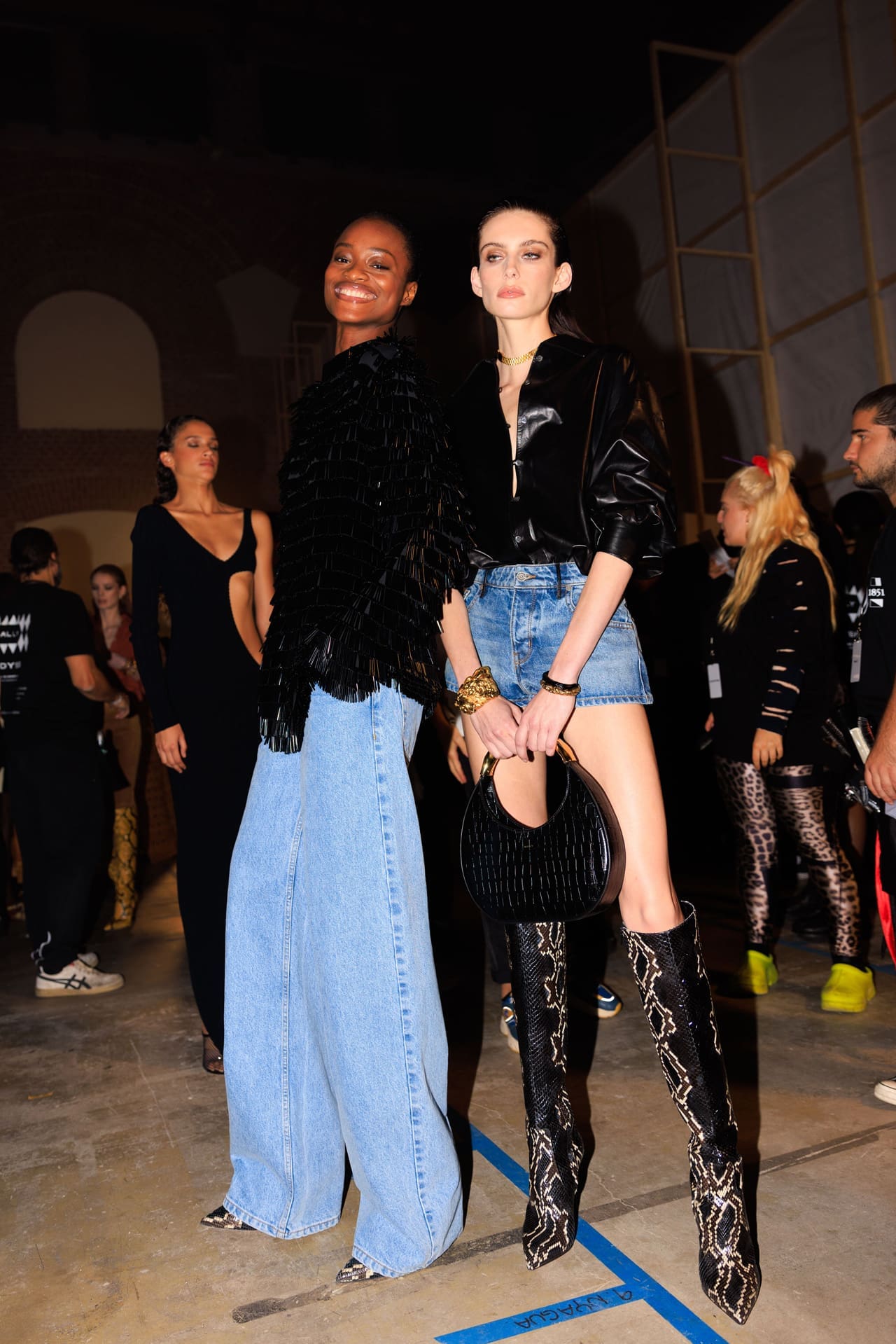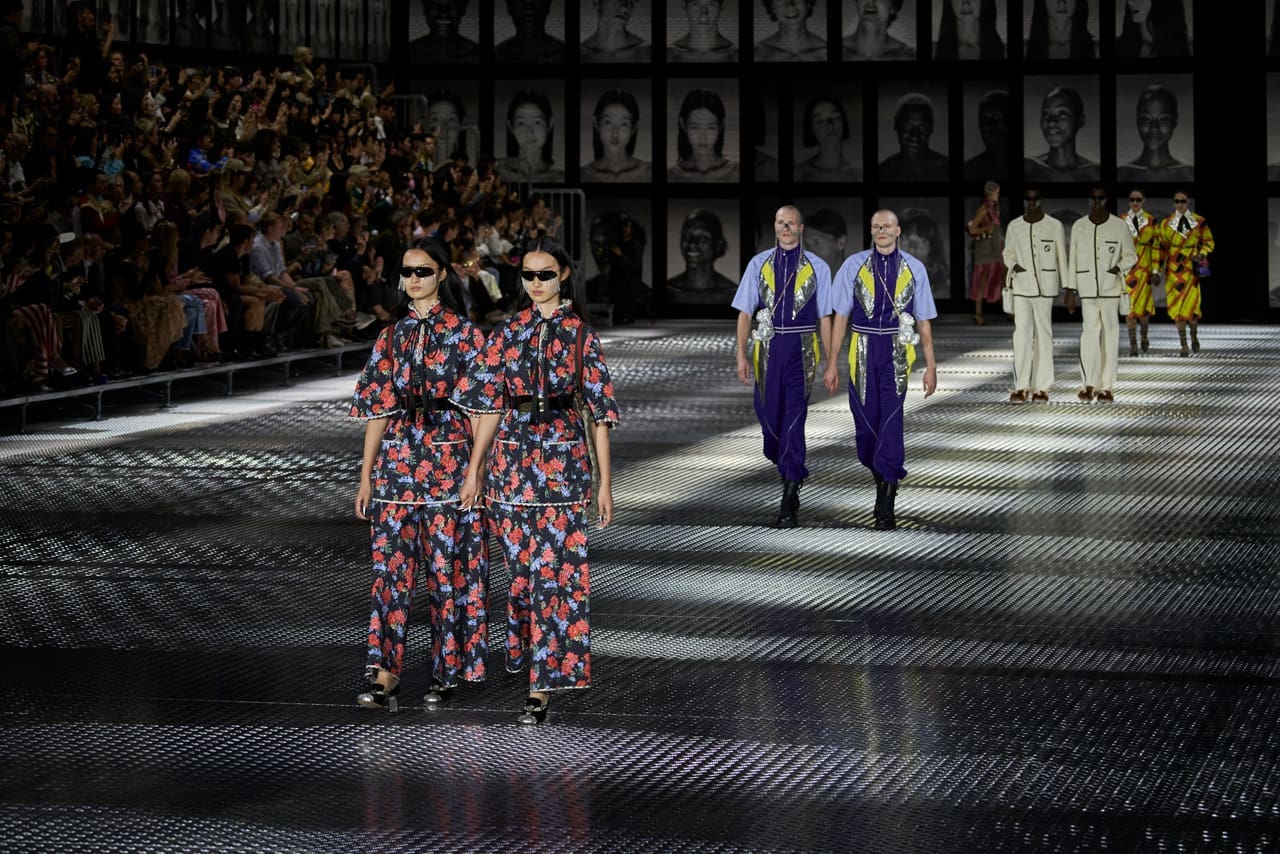Gucci. Matteo Canestraro
Italian heritage houses step to the fashion forefront amidst a season of creative director debuts, grand anniversaries, and a whole panoply of new trends.
Welcome to another roundup of Fashion Week, this time from Milan. As one of the most recognized capitals of style, Milan Fashion Week is a rich turn to heritage houses after the up-and-coming energy of London. Almost 70 runway shows and even more presentations were viewed featuring the colossals of Italian fashion, from Gucci to Prada, Fendi, Versace, Armani, and Bottega Veneta.
Highlights to note in this circuit: the debut of 27-year-old, Fashion East alumni, British Trinidadian-Jamaican, Maximilian Davis for Ferragamo. Yes, the “Salvatore” has, as of the moment, been edited out and along with this revision, the recognizable cursive logo changed to a non-script, modern-looking black serif font. And a new hue for the house: a Davis-particular shade of red that bled into the floors and walls of his runway; a runway that also happens to be the site of Ferragamo’s future Milan hotel. Moncler celebrated its 70th birthday with a grand, Olympics-opener-level show in Milan’s Duomo square: 700 dancers, 200 musicians, 100 choir members, and 952 models to total a precise count of 1,952: The year the house was founded. Other movements in the musical chair of fashion: Designer Marco de Vincenzo takes over the top job at Etro and Filippo Grazioli is newly minted at knitwear brand Missoni.

Filipino Rhuigi Villaseñor’s first collection for Bally brings the 171 year old Swiss brand back to the runways—since its last show some 21 years ago. To the uninitiated, Villaseñor is the man behind Rhude, a luxury streetwear brand based in Los Angeles that cements American iconography with nostalgia. You can read more about him in a Vogue Philippines exclusive interview. Rhude shows in Paris for the menswear shows. And now with Bally, in Milan as well. “Two houses. One I’m building and the other one I’m renovating,” he says on his Instagram account. While the latter can be left to its own quiet construction, we turn our eyes to his take on freshness to recognition. On the new Bally that he’s re-mapping, Villaseñor told Vogue that this first collection is: “being about opulence and sexiness. It’s about what I want to wear when I go out, and what my friends want to wear when they go out, and what I think other people want to wear when they go out.” That meant tailoring in the most sumptuous of fabrics, sexiness in deep V’s and high slits, and slinky dresses in knits that were cut out on one side to focus attention on clavicles, torsos, and a flash of that sexy hip bone.
Then there’s Matthieu Blazy for Bottega Veneta who continued his theme of disguising the extraordinary with the ordinary. The first few looks: a flannel shirt, chinos, and a t-shirt, all look very pedestrian but in fact, are all made out of leather—just like his denim last season. But to prove that wasn’t his only trick, Blazy also manipulated sleeves and trousers to concave fin shapes, reconstructing trouser silhouettes to sculptural forms. Leather manipulation extended to laser-cut flowers giving blooming textures to dresses and skirts. Blazy’s craft expertise can be fully and visually appreciated in his stunning sequences of tactile patterned dresses that were hemmed with fringes of beads, all made by hand.
As for the trends that dominated, we’re zooming in first into the subtle details. Tiny accents that are easy to miss but quick to be picked up by fashion’s fixated who read these changes as portents of things to come. Foldovers are the new style tricks with thin-strapped tanks collapsed to create obi sashes at MM6 Maison Margiela, slips were also unshouldered and left hanging on hips at Sportmax. Meanwhile, at Tod’s, full-torso corsets were turned down halfway for a new cinch on the waist. On the topic of mid-sections, the half-in/half-out belt is the new preferred wrap for Fendi, Alberta Ferreti, and Diesel. And distressed, raw-edged finishes are a recurring theme for Prada, Jil Sander, and Sportmax.

A few more key takeaways that merit indexing for new looks: Long-length layers worn over wide trousers introduce freshness to midi pieces. It was a nude dress over beige pants at Fendi, a calf-length trench on top of trousers at Max Mara, and a summer reinterpretation at Dsquared2 with boardshorts over flares. One essential trouser shape that belongs in your closet right now? The silky cargo. Saturated in jewel tones at Versace, detailed with logo hardware at Fendi, and styled with an extra long belt at Jil Sander. Fringe in various iterations ran rampant on the runways from leather strings to fluffy feathers to handmade beaded curtains that loosened silhouettes. The seasonal update to the fringe is a harder aesthetic by way of rectangle paillettes that give clothes a liquid yet bristly quality. Worn as an eye-searing abbreviated cape at Sportmax and luxurious black contrasted with basics at Bally, where it was paired with jeans.

We can’t end this roundup without talking about how Milan made us see double. Gucci’s collection name: Twinsburg is a fitting reflection on the show’s stars: 68 identical twins. Each pair walked the runway together but was separated with a mirror in the middle. The audience on either side not knowing there was an actual twin behind the reflection. The finale with the divider lifting and revealing the pairs was poetic and emotionally impactful, to say the least. Sunnei, who showed a few hours after had a mind meld with the same duality concept but with an entirely different execution. One twin was in everyday wear and seated with the audience. On cue, twin one stands up, walks down through a revolving door, and out comes twin two in a dressier Sunnei option. “It’s a metaphor of how fashion can act as a transformative force, which is as magical as it is utterly crazy,” Sunnei’s designers Simone Rizzo and Loris Messina explain. But it is with Gucci’s tableau that saw the show’s twins coming together, holding hands, and moving forward as one that squeezed our sentimentality. Somewhere in that gesture is an analogy that we’ll always need someone to hold, that we need to be connected, and that it is in solidarity that we will survive. “When we are many, we are much stronger,” says Alessandro Michele. And that we can argue benefits from a two-fold advantage.
